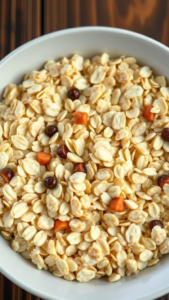Is Oatmeal Allowed on the Keto Diet?
The keto diet focuses on low carbohydrate intake while emphasizing fats and proteins. This dietary approach aims to induce a metabolic state known as ketosis, where the body burns fat instead of carbohydrates for energy. Many people wonder about different foods’ compatibility with this diet, particularly oatmeal. So, is oatmeal allowed on the keto diet? Let’s delve into this topic to provide clarity.
Oatmeal is often praised for its health benefits. It’s a great source of fiber, particularly beta-glucan, which can help regulate cholesterol levels and improve heart health. However, when it comes to the keto diet, understanding its carbohydrate content is crucial.
When considering oatmeal, it’s essential to look at the carbohydrate levels. A standard serving of plain, cooked oatmeal (about 1 cup) contains approximately:
| Nutrient | Amount per 1 cup cooked** |
|---|---|
| Total Carbohydrates | 27 grams |
| Dietary Fiber | 4 grams |
| Net Carbohydrates | 23 grams |
| Protein | 6 grams |
| Fat | 3 grams |
The primary concern for those on the keto diet is the net carbohydrates, which is calculated by subtracting dietary fiber from total carbohydrates. In this case, a typical serving of oatmeal can consume a high percentage of one’s daily carb allowance, keeping it well above the typical limit of 20-50 grams of carbs per day that many keto dieters aim for.
If you’re on the keto diet, the question becomes: are there alternatives to oatmeal that are more keto-friendly? The answer is yes! Here’s a list of low-carb oatmeal substitutes you can consider:
- Chia Seed Pudding: Chia seeds are low in carbs and high in fiber. They also provide healthy fats and protein.
- Flaxseed Meal: Ground flaxseeds can be mixed with water to create a porridge-like texture. They are low in carbs and high in omega-3 fatty acids.
- Almond Flour Porridge: Made from almond flour, this option can be prepared similarly to oatmeal and contains significantly fewer carbs.
- Coconut Flour Porridge: Like almond flour, coconut flour is low in carbs and can be used to create a warm breakfast dish.
While traditional oatmeal isn’t keto-friendly due to its high carbohydrate content, it’s important to note that every diet can be individualized. Some may choose to incorporate small amounts of oatmeal and adjust the rest of their daily carb intake accordingly. However, moderation is key. For a more effective keto lifestyle, focusing on lower carbohydrate alternatives will be beneficial.
Another factor to consider is the toppings. Even if you factor in low-carb oatmeal, toppings can increase the total carb count significantly. Choose high-fat toppings like:
- Coconut oil
- Heavy cream
- Berries (in moderation)
- Nut butters
Oatmeal is not considered a keto-friendly food due to its high carbohydrate content. If you’re adhering to the principles of the keto diet, it is advisable to look for low-carb alternatives while still enjoying various healthy foods. This way, you can maintain a balanced diet that supports your health goals while staying within the desired carb limits to achieve ketosis effectively.
Ultimately, the key to success on the ketogenic diet is understanding what works for you and your body, being mindful of carb intake, and discovering enjoyable, low-carb foods that satisfy your cravings.
Nutritional Profile of Oatmeal: What You Need to Know
When considering the nutritional aspects of oatmeal, it’s essential to understand what this popular breakfast option offers. Oatmeal is loved for its taste and versatility, but its benefits go far beyond that. Let’s delve into the key nutrients found in oatmeal and how they contribute to your diet.
Calories and Macronutrients
First, let’s examine the caloric content. A typical serving size of plain, cooked oatmeal (about 1 cup) offers:
- Calories: Approximately 154
- Carbohydrates: 27 grams
- Protein: 6 grams
- Fat: 3 grams
- Fiber: 4 grams
This macronutrient profile shows that oatmeal is primarily a source of carbohydrates, but it also contains protein and healthy fats, which can keep you feeling full longer.
Vitamins and Minerals
Oatmeal is packed with essential vitamins and minerals that are vital for overall health. Here’s a closer look at some of the key nutrients:
| Nutrient | Amount per serving (1 cup cooked) |
|---|---|
| Iron | 1.9 mg |
| Magnesium | 27 mg |
| Phosphorus | 180 mg |
| Zinc | 1.2 mg |
| Vitamin B1 (Thiamine) | 0.2 mg |
| Vitamin B5 (Pantothenic Acid) | 0.4 mg |
These minerals help with functions such as energy production, muscle function, and maintaining a healthy immune system. The presence of B vitamins is also crucial for converting carbohydrates into energy, making oatmeal a great start to your day.
Health Benefits
Many people include oatmeal in their diets because of the numerous health benefits it offers. Here are a few worth noting:
- Heart Health: Oatmeal is rich in beta-glucans, a type of soluble fiber associated with lowering bad cholesterol levels.
- Weight Management: The fiber in oatmeal helps you feel full, which can prevent overeating later in the day.
- Blood Sugar Control: The slow-release carbohydrates in oatmeal help maintain steady blood sugar levels, making it a good choice for individuals with diabetes.
- Digestive Health: The high fiber content supports digestive health and regular bowel movements.
Types of Oatmeal
Not all oatmeal is created equal, and the type you choose can impact its nutritional profile and health benefits. Here are the common varieties:
- Instant Oatmeal: Quick and convenient, but often has added sugars and preservatives.
- Rolled Oats: These are steamed and flattened, offering a good balance between cooking time and texture.
- Steel-Cut Oats: Less processed and larger in size, providing a chewier texture and a nuttier flavor.
- Oat Flour: Ground oatmeal that can be used in baking and cooking.
Choosing less processed options like steel-cut or rolled oats can maximize health benefits, as they are minimally altered and retain more nutrients.
Oatmeal is not just a simple breakfast choice; it’s a nutrient powerhouse that can benefit your health in numerous ways. Its impressive nutritional profile, filled with vitamins, minerals, and fiber, makes it a great addition to any diet. By selecting the right type of oatmeal and being mindful of what you add to it, you can enjoy its benefits while satisfying your taste buds.
When incorporating oatmeal into your meals, consider experimenting with toppings such as nuts, seeds, berries, or yogurt to enhance both the flavor and nutritional value.
Keto-Friendly Alternatives to Oatmeal
Are you following the keto diet but missing your morning bowl of oatmeal? You’re not alone. Oatmeal is a beloved breakfast choice, but its carb content doesn’t align with keto guidelines. Luckily, there are delicious keto-friendly alternatives that can give you that warm, comforting feel of oatmeal without the high carbohydrate count. Let’s explore some fantastic options that will satisfy your cravings and keep you in ketosis.
Many keto dieters turn to alternatives that are low in carbs and high in healthy fats. Here are some popular substitutes:
- Chia Seed Pudding: Chia seeds are tiny powerhouses packed with fiber, omega-3 fatty acids, and plant-based protein. When soaked in almond milk or coconut milk overnight, they form a creamy, pudding-like texture that mimics oatmeal. Sweeten with a keto-friendly sweetener like stevia or erythritol, and you have a delightful breakfast option.
- Flaxseed Meal: Flaxseeds are another great low-carb alternative. Mix ground flaxseed with water and a pinch of salt to create a porridge-like dish. Adding some unsweetened cocoa powder or a hint of vanilla can take the flavor to the next level.
- Almond Flour Porridge: Almond flour offers a nutty flavor that works well for porridge. Combine almond flour with unsweetened coconut milk and let it simmer. Stir in your favorite sweetener and top with a few berries for a delicious and filling breakfast.
- Coconut Flour Cereal: Coconut flour is extremely absorbent, so be careful with the quantities. Mix coconut flour with eggs and some almond milk to create a pancake-like batter, heat it in a skillet, and you have quick, fluffy oat-free “cereal.”
- Egg-based Dishes: If you’re looking for something hearty, scrambled eggs or omelets provide excellent protein with minimal carbohydrates. You can mix in spinach, cheese, and spices for added flavor.
These alternatives not only keep you within your carb limit but also bring different textures and tastes to your breakfast table. You can customize each one to fit your preferences, adding nuts, seeds, or sugar-free syrups for additional flavor. Here’s a closer look at how these choices may stack up nutritionally:
| Alternative | Net Carbs (per serving) | Fiber | Protein | Fat |
|---|---|---|---|---|
| Chia Seed Pudding (1/4 cup seeds) | 2g | 10g | 5g | 7g |
| Flaxseed Meal (1/4 cup) | 4g | 8g | 6g | 12g |
| Almond Flour Porridge (1/4 cup almond flour) | 8g | 4g | 6g | 14g |
| Coconut Flour Cereal (1/4 cup coconut flour) | 8g | 5g | 6g | 14g |
| Egg-based Dishes (2 large eggs) | 1g | 0g | 12g | 10g |
As you can see, the alternatives to oatmeal can provide you with a good balance of fiber, protein, and healthy fats, while keeping net carbs low. these breakfast ideas into your keto meal plan can keep your mornings interesting, satisfying, and aligned with your dietary goals.
One key strategy to remember when transitioning from oatmeal to keto-friendly options is to focus on flavors and textures. Don’t be afraid to experiment with spices like cinnamon, nutmeg, or even vanilla extract, which can enhance the taste of your meals significantly. You might even find that you enjoy these new alternatives just as much, if not more, than traditional oatmeal!
These keto-friendly alternatives to oatmeal will help keep your breakfasts exciting while maintaining your ketogenic lifestyle. Remember, the goal is to enjoy your meals while staying on track with your health goals. You don’t have to miss out on this beloved breakfast staple; simply switch it up with these nutritious, delicious options.
How to Maintain a Balanced Keto Diet
Following a keto diet can be an exciting journey towards better health and weight management. However, maintaining a balanced approach is crucial to ensure you reap the full benefits of this low-carb lifestyle. Here are some essential tips to help you achieve balance while enjoying the ketogenic diet.
Understand Macronutrients
When on a keto diet, it’s vital to know your macronutrient ratios. Typically, this involves:
- 70-75% of your daily calories from fats
- 20-25% from protein
- 5-10% from carbohydrates
Keeping these ratios in mind can help you maintain ketosis, where your body burns fat for fuel instead of carbs.
Choose the Right Foods
Selecting nutrient-dense foods is essential for sustaining energy levels and promoting overall health. Focus on incorporating the following:
- Healthy fats: Avocados, olive oil, and nuts are excellent choices.
- Low-carb vegetables: Leafy greens like spinach and kale, as well as cruciferous veggies like broccoli and cauliflower.
- Quality protein: Grass-fed meats, wild-caught fish, and eggs are ideal options.
Avoid processed foods and sugar, which can disrupt your progress.
Hydration is Key
Staying hydrated is vital on any diet, especially keto. As your body shifts into ketosis, you may excrete more water and electrolytes. Aim for:
- At least 8 cups of water per day.
- Add salt to your meals to replenish sodium levels.
- Consider magnesium and potassium supplements if necessary.
Proper hydration can help reduce the chances of side effects such as fatigue and headaches.
Plan Your Meals
Planning your meals can prevent last-minute unhealthy choices. Here’s a simple structure to follow:
| Meal | Options |
|---|---|
| Breakfast | Scrambled eggs with spinach and feta |
| Lunch | Grilled chicken salad with avocado and olive oil dressing |
| Dinner | Salmon with asparagus cooked in butter |
| Snacks | Cheese, nuts, or keto-friendly protein bars |
With a well-planned menu, you can avoid regrettable food choices and stay on track.
Listen to Your Body
Everyone’s body reacts differently to dietary changes. It’s essential to pay attention to how you feel. If you notice fatigue or cravings, evaluate your food choices. You may need more fats or well-timed meals to provide the necessary energy.
Incorporate Exercise
Physical activity complements a balanced keto diet. Exercise can enhance your progress and overall wellness. Here are a few effective ways to incorporate movement:
- Strength training: Lifting weights can help maintain muscle mass while losing fat.
- Cardio: Engage in enjoyable activities like walking, swimming, or cycling.
- Flexibility exercises: Activities like yoga can improve flexibility and reduce stress.
Find what you love, and aim for at least 150 minutes of moderate aerobic activity each week.
Track Your Progress
Keep a journal of your meals, workouts, and how you feel. Tracking enables you to notice patterns and adjust as necessary. Use apps designed for keto diets to simplify this process. This will help ensure you’re meeting your macronutrient goals and provide valuable insights into your dietary habits.
Stay Consistent Yet Flexible
While consistency is essential, allow yourself some flexibility. Life happens, and occasional treats are part of a balanced lifestyle. The key is to enjoy these moments mindfully without derailing your overall progress.
Maintaining a balanced keto diet doesn’t have to be complicated. By paying attention to your macronutrients, choosing the right foods, staying hydrated, and planning meals, you can enjoy the journey toward better health. Remember, listening to your body and adjusting along the way is just as important. Happy keto eating!
Debunking Myths About Carbohydrates in the Keto Lifestyle
The keto diet has gained significant popularity, but with that popularity comes a slew of myths, especially surrounding carbohydrates. Many people are confused about how carbs fit into this lifestyle. Understanding these common misconceptions is important for those looking to optimize their keto journey.
One of the most persistent myths is that all carbohydrates must be eliminated on a keto diet. While it’s true that the goal of keto is to minimize carb intake, not all carbohydrates are created equal. The body requires some carbohydrates for energy, and the focus should be on the quality and quantity of carbs consumed.
Many people mistakenly think that fruits are off-limits entirely on keto because of their sugar content. However, many low-carb fruits can be enjoyed in moderation. Berries like strawberries, raspberries, and blackberries are lower in sugar compared to other fruits, making them suitable for a ketogenic diet.
Here are some examples of low-carb fruits that can fit into your keto diet:
- Strawberries: Approximately 6g of net carbs per 100g
- Raspberries: Around 5g of net carbs per 100g
- Blackberries: About 5g of net carbs per 100g
- Avocado: Roughly 2g of net carbs per 100g
Another myth is that you must avoid any form of carbohydrates even if they are healthy. Whole grains, legumes, and starchy vegetables can provide essential nutrients and fiber when eaten occasionally and in moderation. While they are higher in carbs, they can still be part of a balanced diet if managed correctly. It’s essential to track your carb intake and find a balance that works for your body.
Some people believe that consuming carbs during a keto diet will immediately kick you out of ketosis. While high carb intake can disrupt ketosis, the body is more adaptable than many think. Some individuals can tolerate small amounts of carbohydrates without significantly impacting their ketosis levels. Understanding your body’s unique response to carbs can help you make better decisions about your diet.
Myth #4: All fats are good fats while on the keto diet. This belief can lead to an overly indulgent mindset concerning fat intake. Though the keto diet promotes high fat consumption, it’s crucial to differentiate between healthy and unhealthy fats. Focus on incorporating sources of healthy fats like:
- Avocados
- Nuts and seeds
- Olive oil and coconut oil
- Fatty fish such as salmon or mackerel
On the other hand, trans fats, often found in processed foods, can have harmful effects on health and should be avoided at all costs. Being selective about the types of fats you include in your keto diet can support overall health while still maintaining ketosis.
Another common misunderstanding is that “sugar-free” products are always keto-friendly. Just because a product is labeled as sugar-free doesn’t mean it lacks carbs. Many sugar substitutes still contain carbohydrates, which can quickly add up if consumed in large quantities. Always check the nutritional information to avoid unwanted spikes in your carb intake.
It’s also worth noting that some people fear that they must eat large amounts of protein on a keto diet. While protein is essential for maintaining muscle mass, it’s equally important not to overdo it. Consuming excessive amounts of protein can lead your body to convert that protein into glucose through a process called gluconeogenesis, which could interfere with ketosis. Aim for a moderate protein intake tailored to your individual needs.
Many individuals believe they cannot enjoy carbs at all while on the keto diet. This misconception can make the diet feel overly restrictive. In reality, with proper planning, you can incorporate small amounts of carbs and find alternatives that fit your lifestyle better. For example, using almond flour or coconut flour in place of traditional flours can open up a variety of keto-friendly recipes.
In summary:
| Myth | Truth |
|---|---|
| All carbs must be eliminated | Quality carbs can be included in moderation. |
| All fruits are off-limits | Low-carb fruits like berries can be enjoyed. |
| Carbs kick you out of ketosis | Small amounts of carbs can be tolerated by some. |
| All fats are good fats | Choose healthy fats and avoid trans fats. |
| Sugar-free products are keto-friendly | Check nutritional information for hidden carbs. |
Understanding the truth about carbohydrates in the keto lifestyle is essential for success on this diet. By debunking these myths, you can make informed decisions that help you achieve your health goals while still enjoying your meals.
Conclusion
Understanding whether oatmeal is allowed on the keto diet hinges on your personal health goals and the specifics of your carbohydrate intake. While oatmeal is known for its benefits, its high carbohydrate content often makes it a poor fit for the keto lifestyle. With around 27 grams of carbs per cup, oatmeal can quickly exceed the daily carb limit many ketogenic dieters strive to maintain.
If you’re looking for a warm, comforting breakfast option that aligns with your keto goals, consider alternatives such as chia seed pudding or flaxseed meal porridge. These options not only offer lower carb counts but also deliver fiber and healthy fats, keeping you satisfied and aligned with your keto diet plan.
Maintaining a balanced keto diet is crucial. This can be achieved by focusing on low-carb, high-fat foods while incorporating a rainbow of vegetables to ensure you’re getting essential nutrients. Understanding the role of carbohydrates is also vital since many myths surround their place in a healthy diet. Contrary to popular belief, not all carbs are detrimental, and knowing how to choose the right carbs can set you up for sustained energy and success on your keto journey.
Ultimately, whether or not to include oatmeal in your diet is a personal choice. It’s essential to prioritize foods that support your health goals while enjoying the variety and flavors of a well-rounded diet. Embracing keto-friendly alternatives can help you thrive without feeling deprived, setting the stage for long-term success.




